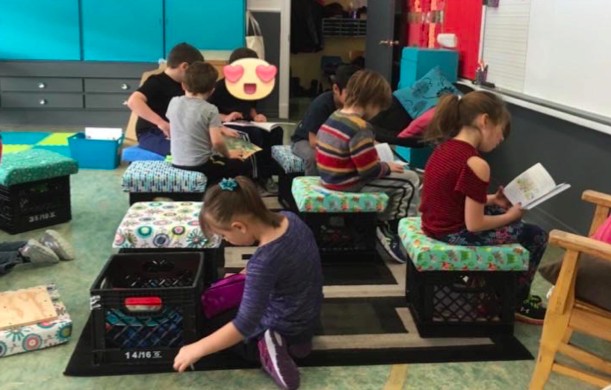Travailler debout, lire allongé par terre, discuter sur un ballon de stabilité… Voilà quelques exemples de ce qu’on peut faire dans une classe « flexible »!
Voyez notre répertoire sur l’aménagement flexible pour trouver d’autres idées!
Derek, élève du 3e cycle, grand créateur de multiples univers dans Minecraft et amateur de jeux vidéos, considère l’école comme un mal nécessaire que doivent subir les enfants, malgré tout l’amour qu’il porte aux enseignantes qui ont croisé son chemin depuis plus de cinq ans.
Lorsqu’on lui montre des photos de classes aménagées en flexible seating, il est impressionné et fortement séduit par ces environnements qui lui rappellent la maternelle, qui ont l’air « cool » et « relax ».
Qu’est-ce que le flexible seating?
Ouvrez la porte d’une classe et voyez ces élèves lire allongés sur un tapis, ou debout travaillant ensemble à un problème de maths pendant que d’autres rebondissent doucement sur des ballons de stabilité. Bienvenue dans une classe à l’aménagement flexible (flexible seating).
Dans une classe flexible, avec ou sans bureau, l’enseignant laisse une grande partie du contrôle et plusieurs choix d’activités d’apprentissage à ses élèves. Les compétences en résolution de problèmes, en pensée critique, en collaboration ainsi que la productivité augmentent, selon ceux qui ont adopté l’approche.
Le monde change. « Nos salles de classe ne devraient pas avoir la même apparence qu’il y a 50 ans », estiment les promoteurs du flexible seating.
Qu’en dit la recherche?
Déjà en 1912, Maria Montessori observait que les enfants assis à leur bureau pour de longues heures devenaient agités, indisciplinés, perdaient leur concentration ou encore devenaient amorphes.
La Clinique Mayo à Rochester, NY, suite à une étude menée auprès de près de 300 élèves pendant une toute une année scolaire, a trouvé que le fait de travailler debout à des tables, de bouger pendant la classe et d’utiliser une variété de postures permettrait notamment de brûler plus de calories. Standing room only in classroom of the future rapporte cette expérience.
Les recherches de Ranjana Mehta, du Texas A&M Ergonomics Center, indiquent aussi que bouger améliore les capacités d’apprentissage. Non seulement les élèves brûlent plus de calories, mais ils sont aussi plus attentifs. Blake, Benden et Zhao (2015) arrivent aussi à des conclusions prometteuse en ce qui concerne l’engagement des élèves.
Les ballons de stabilité sont particulièrement intéressants pour les garçons, écrit K. Wuatt
Les études se poursuivent et indiquent que ces types d’aménagement pour les salles de classe ont des effets favorables à l’apprentissage.
Un groupe Facebook pour l’entraide entre enseignants
Au Québec, ce sont des enseignants qui prennent l’initiative des changements et qui paient souvent eux-mêmes le nouveau mobilier qu’ils se procurent lors de ventes vide-grenier, dans des magasins à rabais ou encore en les construisant carrément. Le tout démontre une bonne dose de créativité chez ces enseignants.
Josée Portelance a créé le 10 septembre 2016 le groupe Facebook francophone Flexible seating. Vous pouvez aussi lire son blogue La classe de Josée, où elle décrit la démarche de transformation de sa classe.
Le groupe Facebook est très dynamique. On y trouve non seulement de magnifiques photos, mais aussi de multiples trucs et conseils. Par exemple, une enseignante demande « Quelle est la hauteur de vos tables basses? Je suis en 1ère année ». Ce à quoi une autre répond : « Le concierge a coupé les pattes des tables avec une scie à métal pour qu’ils travaillent assis sur des coussins ou à genoux. La table est à 37 cm du sol. »
Selon les échanges dans le goupe Facebook, la plupart des élèves aiment le type d’aménagement « flexible », mais certains préfèrent encore les bureaux classiques. On conseille de respecter les préférences des élèves. Certains jeunes élèves de première année seraient même déçus de ne pas entrer « dans une vraie classe »!
Voici quelques citations intéressantes :
« Lorsque j’ai commencé, j’ai permis à mes élèves de s’installer là où ils le souhaitaient. Aujourd’hui, ils ont toujours une place assignée. Certains choisissent d’y passer la majorité de la journée, alors que d’autres n’y sont que lorsqu’ils y sont obligés. »
« Pour certains enfants, choisir une place demande un trop gros effort, ceux avec le TDAH par exemple ».
« Vingt cinq enfants qui se disputent quatre bean-bags, ce n’est pas du flexible seating. » Une enseignante a donc élaboré un tableau de réservation des places « spéciales ».
L’une des enseignantes du groupe explique que le flexible seating est la meilleure façon d’aménager sa classe d’accueil multi-niveau (première à sixième année).
Par où commencer?
Erin Klein, dans EdSurge News de mars 2016, donne les conseils suivants :
- réfléchir à la manière de maximiser l’espace dont vous disposez;
- conserver le maximum d’espace au sol;
- avoir quantité de sièges différents pour accommoder les goûts des élèves;
- les recherches indiquent que les aménagements monochromatiques et les couleurs moins vives fonctionnent le mieux;
- l’idéal est d’utiliser la lumière naturelle au maximum;
- inclure des plantes vertes dans vos plans d’aménagement;
- éviter les affiches laminées qui reflètent la lumière;
- accrocher les affiches au niveau des yeux des enfants;
- prévoir des espaces pour placer le matériel des élèves;
- prévoir plus de sièges qu’il n’y a d’élèves dans la classe.
On recommande aussi d’impliquer les élèves lors du processus de transformation du local. Dans le groupe Facebook mentionné précédemment, un enseignant écrit : « Penser l’espace de travail avec les élèves, c’est aussi montrer qu’on s’intéresse à eux, ce qui n’est pas négligeable pour le climat de la classe et favorise les apprentissages ».
Pour enrichir votre réflexion, vous pouvez aussi lire Jean-Paul Moiraud, Le corps dans l’espace de formation.
Merci à : Édith Beaupré, David Benay, Julie Berthelot, Julien Boisvert, Julie Chandonnet, Caroline Desfossés, Mélanie Demers, Marie-Ève Gagné, Lyne Dugas, Dominik Laforge-Leblanc, Marie-Josée Laprise, Amélie Larrivée, Josée Portelance, Peggy St-Laurent et Caroline Vigneault de m’avoir permis d’utiliser leurs photos pour la courte vidéo qui accompagne l’article. J’espère n’avoir oublié personne!






